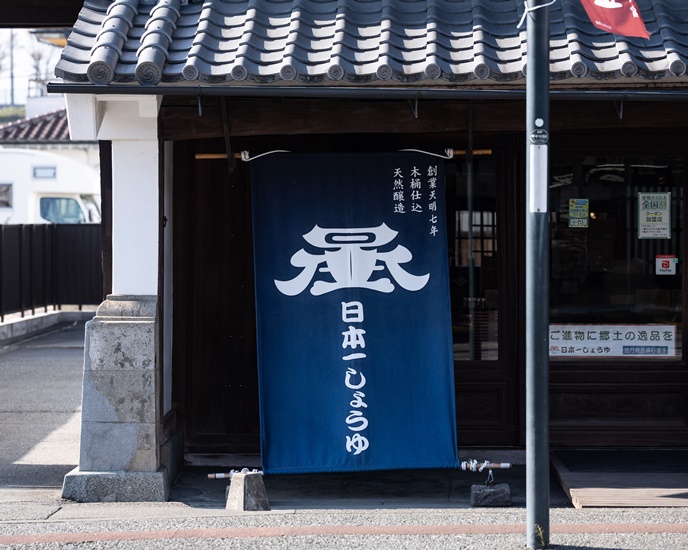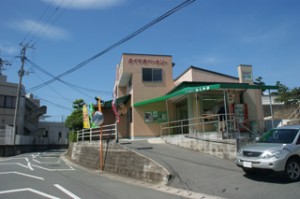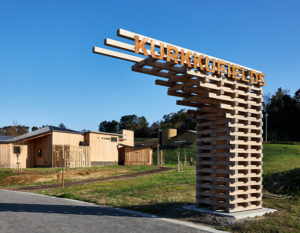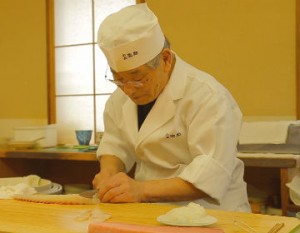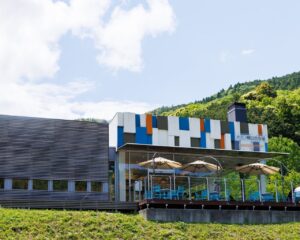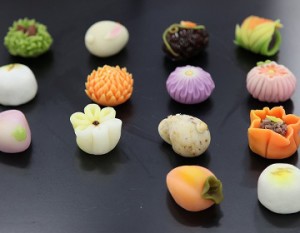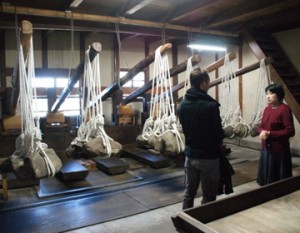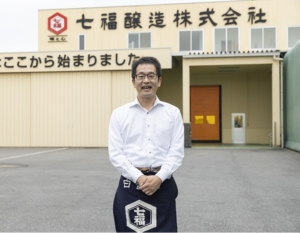Oka Naosaburo Shoten, with a warehouse in Midori-shi, Gunma Prefecture, is a long-established soy sauce brewery with a history of more than 230 years, having been established in 1787 during the Edo period (1603-1868). The Oomama factory, which consists of a brewing factory and the main building that also serves as a store, still continues the traditional soy sauce making process using wooden vats that have been passed down from generation to generation.
Founded in the scenic Omamasa area

Midori-shi, located in the eastern part of Gunma Prefecture, is blessed with rich nature at the southeastern foot of Mount Akagi, and about 80% of its long north-south terrain is covered with mountains and forests. The Oma-Mama Plant of Oka Naozaburo Shoten is located in the Oma-Mama district, halfway between the mountains and the plains. The Watarase River flows nearby, and the Watarase Valley Railway runs alongside the river. Takatsudo Gorge, a beautiful valley praised as the “Yabakei of Kanto,” is famous for its fresh greenery and autumn foliage. It is one of the most popular sightseeing spots in Midori-shi, where visitors can enjoy the magnificent scenery of the river and valley.
Omanama used to be a prosperous post town where people used to come and go as a strategic point on the “Akagane Kaido” road, which transported copper from the Ashio Copper Mine to Edo (present-day Tokyo), and also as a distribution center for silk and raw silk. It is said that Chubei Oka, an Omi merchant, started his soy sauce brewing business under the name of “Kawachiya” in this scenic and water-rich area of Omamata in Jyoshu.
Oka Naosaburo Store, registered as a Tangible Cultural Property of Japan

Even today, the area along Route 122 (Akagane Kaido) from Kiryu to Nikko is dotted with quaint warehouses, merchant houses, and Western-style buildings. The retro atmosphere of the townscape is a strong reminder of the past. It is a great blessing that we are able to preserve the original appearance of the town where the company was founded,” says Shuji Oka, the eighth generation head of the company. Oka Naozaburo Shoten, which stands along a highway, had its Omama factory store, main building, and library registered as a Tangible Cultural Property (building) in 2013. In front of the store, a huge fire oven stands proudly, welcoming visitors.
Natural brewing in wooden vats as in the past

Fermentation and maturation take place slowly in a natural climate. I want to continue to do this for a long time. As Oka-san clearly states, Oka Naozaburo Shoten uses large wooden vats that have been passed down from generation to generation, and they continue to preserve the traditional method of soy sauce making, sparing no time or effort.
Natural brewing, which is dependent on the natural climate and seasonal temperature changes, requires a long fermentation and maturation time of approximately one to one and a half years. Craftsmen check the condition of the mash in wooden vats and stir it to stimulate fermentation, called “oar insertion,” to determine when it is time to press it. The many years of experience and intuition of the craftsmen are indispensable.
The reason why they insist on using wooden vats is that as they continue to use them, microorganisms grow in the brewery and wooden vats, maintaining a comfortable environment for the soy sauce and giving it a flavor that is unique to that brewery. Since there are no craftsmen who can make wooden vats nowadays,” he says, “we are taking good care of the ones we have left. The wooden vats are held in place by a “hoop” made of woven bamboo, and not a single nail is used.
Plant undergoes first major renovation in 100 years

The Omama factory underwent a major renovation in 2017 due to the aging of the warehouse. The soy sauce and miso shops have a tendency to be forgiven because they have a long history, but if they lack cleanliness and neglect safety and security, it’s a complete disaster. We must not leave the old buildings as they are. We cannot survive if we do not ensure safety and security.” With this sense of crisis, the company decided to undertake a major renovation in order to pass the building on to future generations. Two warehouses built in the Meiji period were demolished, and a new steel-frame factory was constructed on the site. With the introduction of the latest equipment, the raw material processing, pressing, and filling operations were renewed under thorough hygiene control to enhance safety and security. The brewing warehouse has also undergone some repairs, but the characteristics of the good old brewing site remain.
What should be new should be new, and what should be left behind should be left behind.

Upon entering the brewery, one can smell the distinctive aroma of fermenting and maturing soybeans. The floor has been replaced with a concrete floor, but the large wooden vats are still in place, giving the brewery a powerful appearance. The wooden vats are not placed on the floor, but rather are floating on the floor so that they can be accessed from below in case repairs are needed. Going up the stairs inside the brewery, one can now see the mash being prepared in the wooden vats from above. The floorboards have been replaced, but the atmospheric ceiling beams remain as they were in the past. The yeast that lives there is the lifeblood of naturally brewed soy sauce. The living yeast that comes with the brewery is a true asset of Oka Naozaburo Shoten. We aim to preserve the traditions that need to be preserved, while at the same time ensuring the safety and security of our products,” says Mr. Oka.
Carefully selected ingredients worthy of the name “Japan’s Best”

The traditional naturally brewed soy sauce produced by Naosaburo Oka Shoten is basically a dark soy sauce that is slowly fermented and matured. The soybeans used to make the soy sauce are whole Japanese soybeans, and the wheat is grown in Gunma Prefecture. In particular, the “ichiban-shibori” (first-strain) and “nidan-brewing” (a brewing method in which koji is added back into the finished soy sauce after it has been brewed a second time), which are popularly known as the “best soy sauce in Japan” (registered trademark), use 100% domestic organic round soybeans and organic wheat, both of which are rare and produced in extremely small quantities among all domestic soybeans. The trademark “Japan’s No.1 Soy Sauce” is a reflection of the strong aspirations of the first generation Omi merchants.
Other popular products include “Tamari Soy Sauce,” which is fermented and aged without wheat using only soybeans and salt and has a rich umami, salty taste and unique aroma, and “Kiage Soy Sauce,” which has the aroma and flavor of freshly pressed koji and live natural yeast that has not been heat-treated. In recent years, the company has been receiving requests from ramen stores to use kiage shoyu, and is gradually increasing the number of customers.
We want to tell our customers more about the wonderful taste of soy sauce.

In the renovated old private house, you can enjoy shopping for a wide variety of processed soy sauce products, including Oka Naosaburo Shoten’s signature naturally brewed soy sauce. You can also enjoy a soy sauce tasting to find the soy sauce you like best. The soft-serve ice cream made with two-step soy sauce is only available at this store. The unexpected combination of rich, thick soy sauce and sweet, milky soft serve ice cream is sure to surprise everyone. It is a “deep taste like caramel,” to use an analogy.

Tours of the brewery are available at any time, and many tourists now visit the brewery. Tourists can also relax in the back room of the brewery after shopping. Naozaburo Oka Shoten, which is also making efforts to contribute to the community by revitalizing the town, is now expected by the locals to become one of the tourist attractions of Midori City.
Mr. Oka says, “My main goal is to make the delicious soy sauce culture available to people not only in Japan but also around the world. For more than 200 years since the Edo period, craftsmen have been using vats that have been passed down from generation to generation to make natural-brewed soy sauce in wooden vats using a traditional method. With Japanese food being registered as a UNESCO Intangible Cultural Heritage in 2013, and with the growing interest in Japanese food culture from overseas, it will not be long before the name “Japan’s No.1 soy sauce” is spreading around the world.



